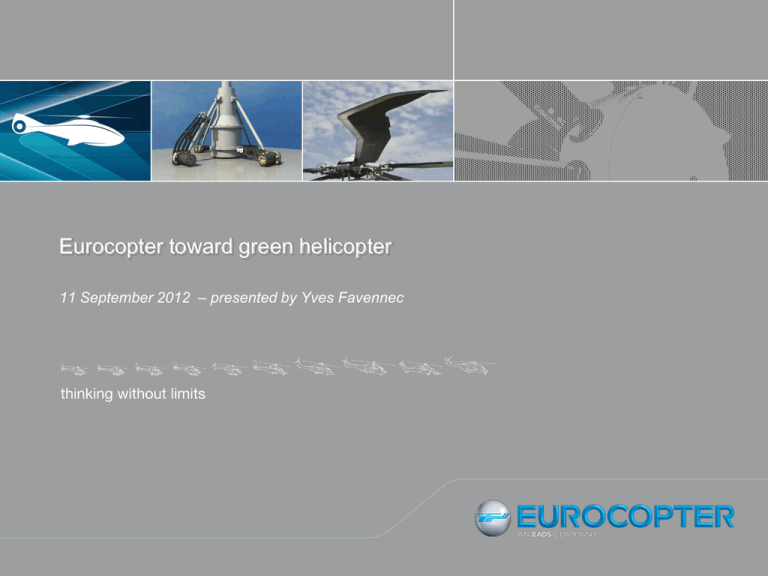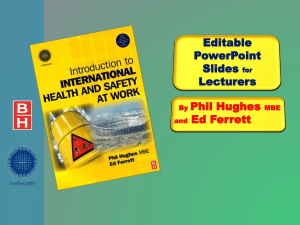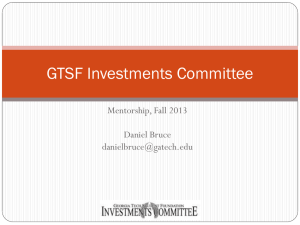
Eurocopter toward green helicopter
11 September 2012 – presented by Yves Favennec
What is "Green" ?
External noise reduction
– Produced noise
– Perceived noise
Emission & fossil fuel consumption reduction
– Consuming less energy
– Producing energy more efficiently
– Non fossil fuels
Eurocopter transparency: a metric for green helicopters
Green manufacturing
2
ETF / Yves Favennec – Solakonferansen 11-09-2012 / 1,v.0 / 11/09/2012 – 17h/
© Eurocopter rights reserved
External Noise: main sources
Main Rotor: Impulsive noise
- Blade-Vortex Interaction
- High-Speed Impulsive
Anti-torque
system
Engines: air intakes
and exhausts
3
True figures to know
What you hear if you are sleeping here
ETF / Yves Favennec – Solakonferansen 11-09-2012 / 1,v.0 / 11/09/2012 – 17h/
© Eurocopter rights reserved
68 dB
In your room, loud and clear!
70 dB
Close to your bed
77 dB
On the road
72 dB
73 dB
4
Rules for noise certification
ICAO noise standard certification for each type of helicopter :
– Maximum permissible noise level.
Helicopter noise level certified to the standard applicable at the date of
the airworthiness:
– If evolution of the type : no obligation to get new certification.
Two standards applicable for noise certification : ICAO Annex 16,
Chapter 8 or Chapter 11 (< 3175 kg).
− Although more restrictive, Standard Chapter 8 supported by EC:
– it includes 3 flight conditions (fly over, take off and approach).
– better reflects human hearing (EPNL instead of SEL).
Therefore, utmost care should be exercised when making comparisons
with competitors:
− Helicopter noises can only be compared when certified under the same
Standard Chapter.
Eurocopter has invested heavily in acoustic research, to
become the leader in this field
5
Eurocopter: the quietest range in the world
Two major innovations gave Eurocopter the leadership:
Automatic variable speed control system.
– Exists on EC130, EC135, EC225
Quiet Fenestron shrouded tail rotor, belonging to the latest generation
of Eurocopter aircraft. It is designed with unequally spaced tail blades.
– Exists on EC120, EC130, EC135, AS365 N3, EC155, EC 145 T2
Some results:
EC120, EC130 and EC135 were the first helicopters to comply with
Grand Canyon National Park most restrictive level .
In 1996, the EC120 and the EC135 were rewarded for the
result in terms of global noise level in their category (Decibel d’Or).
Eurocopter’s modern range is still the quietest in the world.
6
A 30-year experience in noise reduction design
1980
2000
The silent tail rotor (Fenestron®)
ETF / Yves Favennec – Solakonferansen 11-09-2012 / 1,v.0 / 11/09/2012 – 17h/
© Eurocopter rights reserved
1970
Gazelle
Dauphin
EC130
EC135
• Reduced rotation speed
EC120
• Non continuous angular distribution of the blades
• Higher distance between rotor and stator
The reduction of Fenestron® noise
is a topic of continuous research and development,
and Eurocopter is pursuing both passive and active
noise reduction methods.
7
Main rotor noise
Blade-Vortex Interaction (BVI)
-
Cause : Large, impulsive loads induced on the surface of the blade by previously
shed tip vortices.
- Effect :
Loud and annoying popping sound,
efficiently radiated to the far-field.
Mitigation Methods
- Reducing strength/core size of vortices
- Reducing blade response to vortices
- Increasing miss-distance
- Optimization of the blades tip shape
8
GREEN : Bluecopter Technology
Blue Edge™ Blade (EC + Onera)
−
−
−
−
−
A breakthrough in main rotor blade concept.
Double swept design.
Passive concept.
Reduce the typical Blade Vortex Interaction (BVI) noise.
Increase the performances.
9
GREEN : Blue Edge principle
Strong BVI occurs when blade is
‘parallel’ to a vortex.
V
Tip vortices
Parallel interaction on
the entire blade
Blue Edge™ blade concept: Avoid
strong parallel interaction on the
entire blade interaction still
occurs, but is weaker.
V
Tip vortices
Explain
Sound
Parallel interaction only
on part of the blade
10
GREEN : External noise reduction Blue Pulse
Active Blade Control by flaps = Impulsive Noise Reduction
Smart Actuation
World Premiere 8 Sept 2005
Flight with Active Flaps on EC145
–
–
Technology: Piezo-electrically actuated servo
flaps
Benefits:
– Exterior noise & cabin vibration reduction
– Dynamic load reduction
11
GREEN. External noise reduction Blue Pulse
Technology
Flap element
Piezo-actuator
12
ETF / Yves Favennec – Solakonferansen 11-09-2012 / 1,v.0 / 11/09/2012 – 17h/
© Eurocopter rights reserved
GREEN : Friendcopter
To reduce external noise
– Drag
– Active blade trailing edge.
– Flight abatement procedures
Helena code
To reduced engine consumption &
noise at same performance.
Active trailing edge
Modified lateral intakes and gas exhausts
13
ETF / Yves Favennec – Solakonferansen 11-09-2012 / 1,v.0 / 11/09/2012 – 17h/
© Eurocopter rights reserved
GREEN: Friendcopter
HELENA code
– Predict helicopter noise footprints & define new procedures for
low noise approach and take off of EC130/EC135.
– Help manufacturers to predict the external noise of the new
helicopters under certification conditions.
– Support of heliports authorities with respect to noise impact on the
surrounding area.
Application : to all helicopters of Eurocopter
14
Greenhouse effect sources
data (2004)
reserved
ETF / Yves Favennec – Solakonferansen 11-09-2012 / 1,v.0 / 11/09/2012 – 17h/
© Eurocopter
worldwide
IPCCrights
Sources:
= 13.5%
+
Examples of percentages of the global annual emissions
of anthropogenic GHGs (in terms of CO2 – eq)
= 8% !
during the 1970 – 2004 period
= 19.4%
In this period, civil aviation was less than 3% of the total.
= 25.9%
General aviation (out of scheduled & non-scheduled
airliners) is only 1% of the civil aviation, less than 0.03% of
= 2.8% !
Helicopters represent around 1/10th of this total.
+
+
+
+
+
the total world GHGs emissions.
= 13.1%
A very small figure indeed! So what is the contribution of
helicopters? Infinitesimal!!
… but in 2005, part of transportation has grown to 23%, of which only 2.65%
were from Aviation activities
15
The turbine’s gas emissions
N2 75.2%
CO2 & NOX have a negative impact on the
+
greenhouse effect. CO2 is cumulative and permanent.
O2 16.3%
ETF / Yves Favennec – Solakonferansen 11-09-2012 / 1,v.0 / 11/09/2012 – 17h/
© Eurocopter rights reserved
+
NOx is decayingin time but affects population health.
Other 8.5%
CO2
72%
+
Air
+
H2O 27.6%
+
Other 0.4%
N2
+
O2
Kerosene
C12H23…
Soot 0.1% + UHC 4%
+
CO 11.9%
Average figures (% in weight)
+
NOX 84%
UHC = Unburned Hydrocarbon
16
CO2 emissions reduction: a huge challenge
Aviation has the highest steady growth rate; and CO2 has become the primary threat …
… to the aviation industry growth
Growth in passenger/km
% of CO2 Emissions compared to year
2000
ETF / Yves Favennec – Solakonferansen 11-09-2012 / 1,v.0 / 11/09/2012 – 17h/
© Eurocopter rights reserved
500
Possible improvement in flights management
400
Impact of best possible available technology
300
200
Effect of alternative fuels
100
“Sustainable” aviation emissions targets
0
2000
2010
2020
2030
2040
2050
(Courtesy
)
Aviation is an essential part of the world economy. To fill the gap, the aviation industry must
develop new technologies; and share the technical benefits in order to offer cost effective
“green” aircraft.
Growth rate estimated in early 2008, before the world economical crisis.
17
What is a “green” helicopter engine?
ETF / Yves Favennec – Solakonferansen 11-09-2012 / 1,v.0 / 11/09/2012 – 17h/
© Eurocopter rights reserved
Compared to the today’s turbine, it is an engine with drastic
reduction of pollution during all cycle life See Clean Sky / ACARE
targets:
–
Fuel consumption: rate reduction of pollution directly in relation with fuel
reduction rate.
–
CO2 reduction: directly dependant on fuel reduction but can also be
achieved by some alternative fuels.
–
NOx reduction: benefits from SFC reduction but can only be radically
reduced by using specific combustion technologies.
–
Noise reduction: achieved by emission reduction and emission attenuation.
–
Application of REACH regulation: eliminates from product and processes
the substances and products which are dangerous for health and
environment.
18
Reduction of gas emissions: already done ….
Facts & Figures:
ETF / Yves Favennec – Solakonferansen 11-09-2012 / 1,v.0 / 11/09/2012 – 17h/
© Eurocopter rights reserved
From the 50ties to the early 90ties the consumption has been dramatically reduced:
Artouste 2C
=
144 kg/h
=
33% consumption less!
Arrius 2F
=
97 kg/h
=
3.03 kg CO2/km
50% emissions less!!!
1.50 kg CO2/km
+ More power (safety) and higher speed (time saving)
Beyond the Clean Sky targets, in 2020, the specific consumption of a 500/800
kW turbo-shaft engine will have decreased by 16% since 2000.
Arrius: CO2 emissions have been reduced by 15% over the last 10 years.
Arrius: NOx emissions have been reduced by 65% over the last 10 years.
19
Alternative fuels: technical and logistic points
to be cleared
ETF / Yves Favennec – Solakonferansen 11-09-2012 / 1,v.0 / 11/09/2012 – 17h/
© Eurocopter rights reserved
The CO2 reduction is directly dependant on fuel reduction but can also be
achieved by some alternative fuels; but they must offer:
–
Suitability: specific
compatibility, …
–
Sustainability: long term potential, lower impact on the environment (GHG) during
the full “life cycle process” of the product, impact of extraction on resources, …
–
Industrialization: mass production, acceptable cost, distribution, …
energy,
combustion
characteristics,
storage
stability,
Examples of points to be checked:
–
To insure that bio-fuels bring CO2 reduction on full cycle and without
competition against human nutrition and not detrimental to world forest areas
–
Physical-chemical properties of synthetic fuels: lubrication capability, energetic
density, compatibility with other materials, behavior at extreme T° (high and low)
…
20
Alternative fuels: on-going research program
The goal of DREAM (WP5), is to demonstrate, only for technical aspects,
ETF / Yves Favennec – Solakonferansen 11-09-2012 / 1,v.0 / 11/09/2012 – 17h/
© Eurocopter rights reserved
the ability of a turboshaft engine to operate with alternative fuel.
–
Selection of the most appropriate fuel brand.
–
Fuel impact on engine systems.
–
Tests of components.
–
Demonstration incl. long endurance tests on
existing engine.
–
Demonstration that alternative fuels (50% JetA1 + 50% HVO (UOP)) can be used
in an aero-engine without major modification and in H/C fuel system. Official
approbation of ASTM standard D7566-11: up to 50% bio derived jet fuel can be
added to conventional jet fuel for commercial use.
21
Optimal: to save fuel by saving time
Optimised Procedures and Techniques for Improvement
of Approach and Landing.
ETF / Yves Favennec – Solakonferansen 11-09-2012 / 1,v.0 / 11/09/2012 – 17h/
© Eurocopter rights reserved
Air-ground co-operative project, which is aiming to define and assess:
a) Innovative procedures for the approach and landing phases of aircraft and rotorcraft.
b) New ATC tools and new airborne functions to support these new procedures.
Rotorcraft SPECIFIC procedures:
–
Specific IFR approach
based on GBAS, SBAS
–
Steep / Curved / Segmented IFR
approaches
–
Simultaneous Non Interfering (SNI) IFR
procedures
–
Enablers: GBAS, SBAS.
procedures
At the same scale !
22
ETF / Yves Favennec – Solakonferansen 11-09-2012 / 1,v.0 / 11/09/2012 – 17h/
© Eurocopter rights reserved
Eurocopter: a member of the “Clean Sky”
project
Joint Technology Initiative “Clean Sky” for Aeronautics
& Air Transport
– Clean Sky JTI is one of the largest European research
projects
– Budget: €1.6 billion, equally shared between the
European Union (DG Research) and industry,
– Aim: to speed up technological breakthrough
developments and shorten the time to market for new
solutions tested on Full Scale Demonstrators.
– Target: To reduce noise, gas emissions and impact of
aviation industry on the environment
Eurocopter : funding member of the JTI and co-leader of
the Rotorcraft ITD
23
Clean Sky: A Joint Technology
Initiative
• All market segments
addressed
• Whole supply chain
involved
ETF / Yves Favennec – Solakonferansen 11-09-2012 / 1,v.0 / 11/09/2012 – 17h/
© Eurocopter rights reserved
6 Integrated Technology Demonstrators (ITD)
• Integration of mature
techno bricks
Eco-design
for Airframe and Systems
Smart Fixed-Wing
Aircraft
Green Regional
Aircraft
Green Rotorcraft
+ AgustaWestland
Sustainable
and Green
Engines
Clean Sky Technology
Evaluator
Systems for Green
Operations
24
ETF / Yves Favennec – Solakonferansen 11-09-2012 / 1,v.0 / 11/09/2012 – 17h/
© Eurocopter rights reserved
GRC technical objectives
Halving noise
REACH compliance
Green Life Cycle
Emissions reduction
25
GRC technical objectives
Project
ETF / Yves Favennec – Solakonferansen 11-09-2012 / 1,v.0 / 11/09/2012 – 17h/
© Eurocopter rights reserved
GRC1
(blades)
GRC2
(drag)
GRC3
(electrical systems)
GRC4
(Diesel engine)
Foreseen Demo Configurations
Ground
testing of a full scale active blade segment
Downscaled wind tunnel model with active and passive blades
Flight with optimised rotor (Westland, TBC)
Downscaled
wind tunnel model
Flight with modified rotor hub fairings; improved turboshaft engine installation
Virtual H/C integrator
New
electrical architecture for medium/heavy helicopters with corresponding
equipment tested on “Copper Rig”
Modified
EC120 (2 ton class) with Diesel engine to be adapted/developped
GRC5
(Flight path)
Quiet departure & landing to/from :
Airport with commercial traffic (SNI Simultaneous Non Interfering)
Heliport
IFR & VFR fuel-saving routes
GRC6
(Eco-Design
Rotorcraft Airframe)
Industrial applicability of EDA* results of full life cycle for :
Typical helicopter composite components : door, cabin floor
Typical helicopter metallic components : gear box housing and gear
* EDA= EcoDesign for Airframe (generic for all types of aircraft)
26
ETF / Yves Favennec – Solakonferansen 11-09-2012 / 1,v.0 / 11/09/2012 – 17h/
© Eurocopter rights reserved
GRC technical objectives
27
GRC1 - Innovative Blades
Reduction of both Noise & Power Demand, by means of :
– Design optimization i.e. tailoring of shape & structure
ETF / Yves Favennec – Solakonferansen 11-09-2012 / 1,v.0 / 11/09/2012 – 17h/
© Eurocopter rights reserved
– Active control esp. active twist
Based on background from earlier / on-going projects :
− Friendcopter (WP5):
− Active flexible trailing edge
− Active twist
− GOAHEAD
− Computational Fluid Dynamics
− Wind tunnel data base
28
GRC2 - Drag Reduction
Drag Reduction of airframe & non-lifting rotating components :
ETF / Yves Favennec – Solakonferansen 11-09-2012 / 1,v.0 / 11/09/2012 – 17h/
© Eurocopter rights reserved
– Main and tail rotor pylon & hub
– Fuselage-tail junction
Hub
Powerplant
– Turbo-shaft engine installation
(intakes, nozzles)
– Tail unit and tail surfaces
– Shape optimization
Methods:
– Active flow control
– Wind tunnel tests & flight demos
Tail unit
Results:
– Lower fuel consumption & CO2
Tail cone
29
GRC3 – Electrical Systems
ETF / Yves Favennec – Solakonferansen 11-09-2012 / 1,v.0 / 11/09/2012 – 17h/
© Eurocopter rights reserved
Goal : removal of hydraulic fluid, deletion
of engine bleed air circuit.
Efficient electrical generation, conversion
and distribution (generic for small aircraft).
Electromagnetic Actuators for helicopter
flight control (ground testing).
Efficient power generation and control for
piezoelectric actuation, esp. active blades.
Electrically driven Tail Rotor (concept
studies).
30
GRC5 – Environment-Friendly Flight Paths
ETF / Yves Favennec – Solakonferansen 11-09-2012 / 1,v.0 / 11/09/2012 – 17h/
© Eurocopter rights reserved
SNI shorter routes to minimise fuel emission and gas emission
IFR & VFR approach and departure procedures (noise footprint minimization)
Low level VFR & IFR en route navigation (noise impact minimization)
Consistency of IFR low noise procedures with ATM (Simultaneous non Interfering
approaches)
In IFR conditions, automatic generation of low noise flying path (implementation
of predictive noise footprints and automatic low noise flight through FM –
automatic pilot)
In VRF conditions, real time update of noise footprint model (through a board
sensors) allows the pilot to follow the lowest noise flying path.
31
GRC4 – Installation of Diesel Engine
Target : light single helicopter (EC120)
Investigation of the concept
ETF / Yves Favennec – Solakonferansen 11-09-2012 / 1,v.0 / 11/09/2012 – 17h/
© Eurocopter rights reserved
Integration study
Engine specification => Partner to develop /
adapt
Ground testing (+flight beyond Clean Sky)
Cruise
Take-off
32
Installation of a Diesel engine on a light
helicopter
ETF / Yves Favennec – Solakonferansen 11-09-2012 / 1,v.0 / 11/09/2012 – 17h/
© Eurocopter rights reserved
Rationale and technical targets:
– Small turbine engines helped the light multi-mission helicopter market
to grow fast from the fifties, thanks to significant advantages w.r.t.
AVGAS piston engines :
– Automatic control of the rotor speed.
– Large weight saving, despite higher fuel consumption and bigger tanks.
– Better safety without carburetor and ignition problems.
– Further improvements beneficial to all sizes of helicopters came :
– Free turbine engines helped to get rid of clutch problems.
– Digital control units helped to optimize the engine power ratings all over the flight
envelope and to improve safety.
– Diesel car engines made tremendous progress in the fields of :
– Direct high pressure fuel injection.
– Digital control system.
– Turbocharger.
– Emissions control.
In addition to the large reliability improvements of all components specific
to reciprocating engines brought by the huge car market and competition.
33
Installation of a Diesel engine on a light
helicopter
Rationale and technical targets…
ETF / Yves Favennec – Solakonferansen 11-09-2012 / 1,v.0 / 11/09/2012 – 17h/
© Eurocopter rights reserved
– Today, the advantages of such modern Diesel engines for helicopters
are clear :
– the engine maximum power can be down sized by approx. 20 % thanks to
the turbocharger which provides constant power up to high altitudes,
– the thermodynamic efficiency is in the range of 32-35 %, instead of 25 %
for small turbine engines the sophistication of which is limited by the cost
aspects
– the maximum efficiency (i.e. the minimum fuel consumption) is kept on a
large power range, and not only at the Take-off power.
– the installation power losses at the level of air intakes and exhausts are
potentially eliminated.
– The helicopter market has the opportunity to take advantage of
synergies with the car industry in terms of :
–
–
–
–
reduce rate of FOSSIL FUELS USE.
engine EMISSIONS CONTROL and REDUCTION.
further EFFICIENCY improvements.
COSTS and SUPPORT network.
34
Installation of a Diesel engine on a light
helicopter
Rationale and technical targets…
ETF / Yves Favennec – Solakonferansen 11-09-2012 / 1,v.0 / 11/09/2012 – 17h/
© Eurocopter rights reserved
– Preliminary analysis helped to define the following targets :
– 45 % average fuel consumption reduction.
– 50 % NOx emission reduction.
– 500% CO (poison gas) emission reduction.
– TBD % CO2 emission reduction (no reference known on turbines, but
should follow the fuel consumption reduction).
– TBD % (> 100%) particles emission reduction thanks to particle
filters.
Viability of the concept is closely linked to a weight optimization of piston
engines and integration into the helicopter in order to recover the empty
weight penalty through fuel savings in less than 1 HOUR flight time, instead of
a 2.5 hours order of magnitude with the current available data.
35
How to Measure Environmental
Performance
Need for environmental information
ETF / Yves Favennec – Solakonferansen 11-09-2012 / 1,v.0 / 11/09/2012 – 17h/
© Eurocopter rights reserved
– Public
acceptance of helicopter activities is under attack
–Compliance: ever-demanding environmental regulations
–Market demand: emerging need to understand helicopter’s
environmental performance
Need for a specific indicator
–Simple to understand: visual, transparent, honest
–Specific to helicopters and different from other means of
transportation
–Could become an industry standard
Need for an additional benchmark tool
–Environment is another criterion for selection in addition to
performance, safety, costs, DMC, comfort, etc.
–Will trigger R&D efforts in environmental areas
36
ETF / Yves Favennec – Solakonferansen 11-09-2012 / 1,v.0 / 11/09/2012 – 17h/
© Eurocopter rights reserved
3 Life Cycle Stages, 2 Predominant
Criteria
Over the entire life cycle,
the operation phase
contributes to up to 70%
of a helicopter’s total
environmental
impact
Noise and emissions
are dominant during
operations
37
3 Life Cycle Stages, 2 Predominant
Criteria
« Eurocopter believes that transparent environmental communications
by the rotary-wing aircraft industry is essential to building a relationship
of trust with the public, and it encourages industry stakeholders as well
as to invest heavily in the protection of the environment » Eurocopter
President & CEO Lutz Bertling said.
The following metrics (noise and emission) has been established and
published by Eurocopter.
The committee’s efforts resulted in proposals for slight modifications of
Eurocopter’s initial environmental performance indicators and the
company now plans to integrate these recommendations in the
definitions of environmental indicators.
In the frame of an AHS Int’l ad hoc committee, it has been discussed
with the other manufacturers.
38
ETF / Yves Favennec – Solakonferansen 11-09-2012 / 1,v.0 / 11/09/2012 – 17h/
© Eurocopter rights reserved
Perceivable Noise
39
ETF / Yves Favennec – Solakonferansen 11-09-2012 / 1,v.0 / 11/09/2012 – 17h/
© Eurocopter rights reserved
Emissions: equivalent CO2 = f (fuel flow)
40
Flight Hours Rather Than Distance
Emission as a function of distance
ETF / Yves Favennec – Solakonferansen 11-09-2012 / 1,v.0 / 11/09/2012 – 17h/
© Eurocopter rights reserved
– Already an established standard for cars = CO2/ km.
– Airliners do not compete favorably.
– Totally inappropriate for helicopters.
Emission factor should consider helicopter’s multi-role capacity
– Point-to-point transportation accounts for just 30% of total
missions.
– Aerial work and SAR missions are performed at hover.
– Time generally matters more than distance.
What is an average mission profile?
– Hover: 10%
– Vbe: 30%
– 120 kts: 60%
41
ETF / Yves Favennec – Solakonferansen 11-09-2012 / 1,v.0 / 11/09/2012 – 17h/
© Eurocopter rights reserved
Metrics
C
42
ETF / Yves Favennec – Solakonferansen 11-09-2012 / 1,v.0 / 11/09/2012 – 17h/
© Eurocopter rights reserved
Appendix: Eurocopter Compared to
Competitors
43
Eurocopter commitment to “industrial”
environment
Context
– Eurocopter is working in a worldwide competition.
ETF / Yves Favennec – Solakonferansen 11-09-2012 / 1,v.0 / 11/09/2012 – 17h/
© Eurocopter rights reserved
– Regulations are national, European or/and worldwide.
– Management of obsolescence is a legal necessity but
Eurocopter set up a preventive policy and is working in
advance.
Difficulties
– Actors (Customers, Suppliers) are not in the same
regulatory system (Europe, Asia, Americas…).
– Legal requirements are at different levels (Europe, States,
Regions), applicable rules also depend on internal policy,
contract specifications, export authorizations,… .
Protection of the Environment: a global approach
– ISO 14001: an Eurocopter group willingness
– REACH: an European regulation (1st June 2007)
44
ISO 14001: To improve the environmental
situation.
ETF / Yves Favennec – Solakonferansen 11-09-2012 / 1,v.0 / 11/09/2012 – 17h/
© Eurocopter rights reserved
Key issues: ISO 14001 introduction for a transversal
organization allows:
– Taking into account of the environmental impacts of
Eurocopter’s activities and services at every level.
– Matching the suitable responses with socio-economic and
legal requirements.
The goal is to be in accordance with the most stringent
rules related to environmental protection for the following
activities:
– Surface treatment
– Painting materials and processes
– Management of wastes
– Control of chemicals and studies for substitution if necessary
– Reduction of atmospheric emissions and power consumptions
– Products recycling or “green” elimination processes
45
French sites environmental actions plan
ISO 14001 Certified
Improved management and use of chemicals:
ETF / Yves Favennec – Solakonferansen 11-09-2012 / 1,v.0 / 11/09/2012 – 17h/
© Eurocopter rights reserved
– To ensure 100% traceability
– To secure 100% procurements
Control of atmospheric emissions:
– To realize 100% of mandatory measurements
– Reduction of VOC emissions: 40% Marignane,
65% La Courneuve
To improve waste’s management = reduction
of 3%, valorization 70 %
Reduced consumptions:
– Energy = - 3%
To develop sense of responsibility towards:
– 100% staff awareness of environmental issues.
– 100% of the most important internal suppliers.
46
Environmental technology for “green”
environment
Donauwörth
ISO 14001 Certified
ETF / Yves Favennec – Solakonferansen 11-09-2012 / 1,v.0 / 11/09/2012 – 17h/
© Eurocopter rights reserved
– Surface treatment sector: the painting booths have been equipped with an air flow
rate system of 160,000 m3/h.
– Heating plant (40 MW): ultramodern control system and new pumps are parts of the
equipment which will reduce CO2 emissions by 25% per kWh and will decrease the
consumption by around 10%. Investment: € 240,000.
Advantages of the systems:
• Cost reduction
• Reduction in CO2 emissions
• Reduced emissions of particles
In June 2008, the adhesion of ECD to the
Bavarian Environmental Pact was signed.
This is a commitment that ECD environmental
efforts will go beyond legal requirements.
47
Environmental technology for “green” air
La Courneuve: the new Blades Finishing Workshop recently inaugurated.
ETF / Yves Favennec – Solakonferansen 11-09-2012 / 1,v.0 / 11/09/2012 – 17h/
© Eurocopter rights reserved
ISO 14001 Certified
Among the goals:
– to reduce environmental impact,
– to use substitution goods,
– to decrease the risks for workers by design,
– to minimize the risk of fire.
− Dust particles picked up by sucking devices at the
source (sanding machine),
Painting booths only fed with clean air and equipped
with filters,
−
Replacement of 2 or 3 products by only one being a
lower rate of Volatile Organic Compounds emission,
−
Substitution of primary paints by other ones less
dangerous.
−
48
Environmental technology for “green”
protection
Albacete
ETF / Yves Favennec – Solakonferansen 11-09-2012 / 1,v.0 / 11/09/2012 – 17h/
© Eurocopter rights reserved
− Innovative infrastructure with recycling system based on the
prevention principle.
−
Different types of waste sorted and collected separately.
Site’s underground sewage network designed to minimize
maintenance overheads by limiting the output of untreated waste,
reducing noise emissions, spillage and accidental release, while
cutting energy consumption.
−
− Internal audit, preliminary appraisal and certification audit are
planned by end of in the coming weeks.
− Workshops team leaders have received training on environmental
impacts of production activities.
ISO 14001 Certified
49
REACH: Registration, Evaluation and
Authorization of Chemicals
Objective : EU regulation to protect human health
and environment.
ETF / Yves Favennec – Solakonferansen 11-09-2012 / 1,v.0 / 11/09/2012 – 17h/
© Eurocopter rights reserved
Will impact:
- chemical elements (natural or obtained
by manufacturing),
- their compounds,
substances containing them.
-
all
New way of doing Business = Reversal of the
burden of the proof:
– Industrials to prove the safe use for each substance.
– Major legal liability (criminal, civil, administrative).
– Each use not formally authorized is forbidden.
– Information to be exchanged throughout the supply
chain, to be transmitted to customers and employees
“Tool”: European Chemicals Agency – Located Helsinki
50
REACH: Technologies must be into “Green
Fields”
ETF / Yves Favennec – Solakonferansen 11-09-2012 / 1,v.0 / 11/09/2012 – 17h/
© Eurocopter rights reserved
Better evaluation of the risks throughout their cycle of life and
progressive elimination of the most hazardous substances of which the
residual uses will be under authorization.
Among 30,000 substances, 3,000 declarable ones,
…….
of which 300 may have to be replaced.
Carcinogenic, mutagenic, toxic to reproduction
Very toxic to aquatic organisms, may
cause long-term adverse
effects in the
aquatic environment
Business risks: “No data = no market” => potential supply
chain disruption
51
Conclusion
The "greener helicopter" is not a luxury
– More & more a prerequisite of the acceptance of rotorcrafts by
the "civilian society" and thus a condition for the operators to
increase the scope of their operations.
Lost of "greener" is of course a key point: it must not endanger the
profitability of the sector.
"Green" is one of the 4 research axes of Eurocopter
– It must be consistent with the 3 other ones:
Safety
Cost reduction
Extension of the fields of use
Eurocopter is investing in a consolidated matter in these directions to
propose to its customers, products even more adapted to the needs of
tomorrow
52





